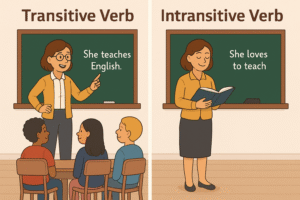Grammar Puzzle Solved (1): Can the word ‘teach’ be used as both a transitive and an intransitive verb?
Teach as Transitive and Intransitive Verb
Answer:
Before delving into whether ‘teach’ can function as both a transitive and an intransitive verb, let us first explore what transitive and intransitive verbs are.
Transitive Use
A transitive verb requires a direct object (something or someone that receives the action). In this case, “teach” is followed by a noun or pronoun that indicates what is being taught or to whom something is taught.
Examples:
- She teaches English. (“English” is the direct object.)
- He taught the students grammar. (“The students” and “grammar” are direct objects.)
- They teach Mathematics to children. (“Mathematics” is the direct object, and “children” is the indirect object.)
-
The professor teaches physics every semester.
(“Physics” is the direct object.) -
She taught her son the alphabet.
(“Her son” is the indirect object, “the alphabet” is the direct object.) -
We teach coding to beginners.
(“Coding” is the direct object, “beginners” is the indirect object.) -
The coach taught the players new strategies.
(“The players” is the indirect object, “new strategies” is the direct object.) -
He teaches history at the high school.
(“History” is the direct object.
Intransitive Use
An intransitive verb does not take a direct object. Importantly, when used intransitively, ‘teach’ refers to the general act of teaching without specifying what is being taught.
Examples:
- She loves to teach. (No object, just the action of teaching.)
- He has been teaching for years. (No direct object, just duration.)
- They teach at a local school. (“At a local school” is a prepositional phrase, not a direct object.)
-
I want to teach someday.
(General desire to teach, no specific object.) -
She decided to teach after graduation.
(The focus is on the act of teaching, not what is taught.) -
They teach in the afternoons.
(“In the afternoons” is a time phrase, not a direct object.) -
We have been teaching since 2010.
(No direct object—only the timeframe is mentioned.) -
He continued to teach despite the challenges.
(The verb “teach” stands alone without a direct object.
Thus, the verb “teach” can be transitive as well as intransitive, depending on how it is used in a sentence.
In this way, “teach” functions as both a transitive and an intransitive verb, depending on context.

To read notes on English Literature, follow the link: https://englishlitnotes.com/
To read Notes on English for All Classes, follow the link: www.englishwithnaeemullahbutt.com/
How do articles cause common noun mistakes in English grammar?
https://grammarpuzzlesolved.englishlitnotes.com/use-of-article/
For the reading of any material related to grammar, follow the link: https://chat.openai.com
Discover more from Grammar Puzzle Solved by Naeem Ullah Butt
Subscribe to get the latest posts sent to your email.